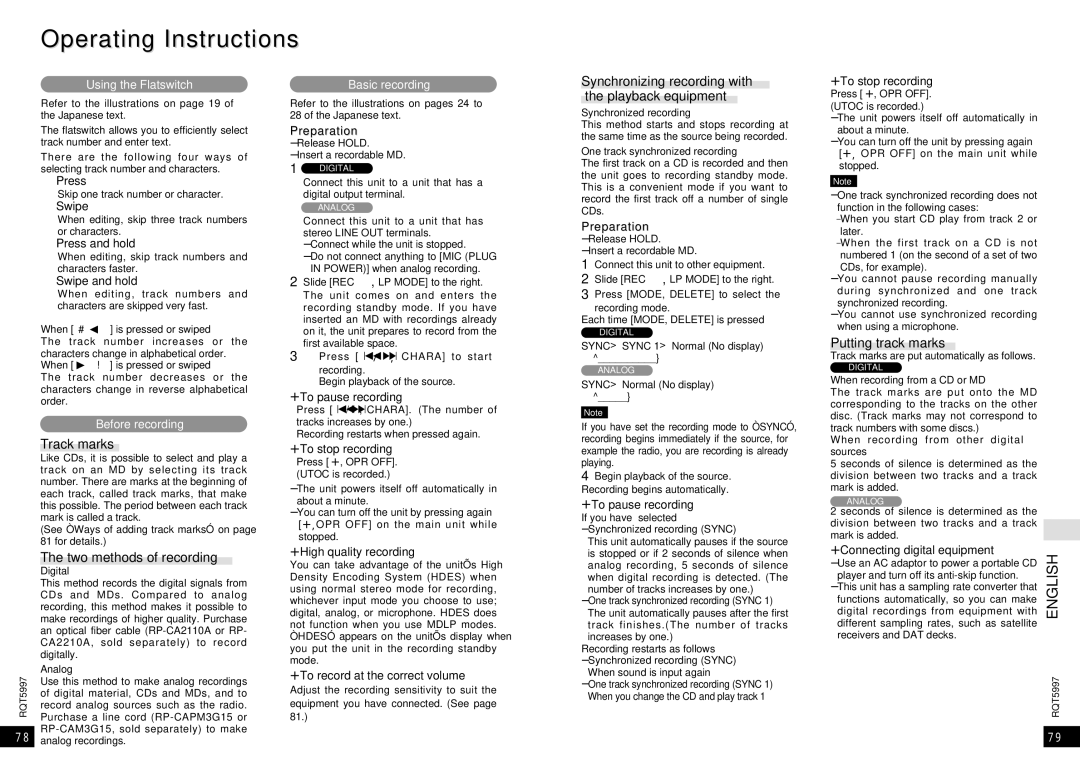
Operating Instructions
RQT5997
78
Using the Flatswitch
Refer to the illustrations on page 19 of the Japanese text.
The flatswitch allows you to efficiently select track number and enter text.
There are the following four ways of selecting track number and characters.
1Press
Skip one track number or character.
2Swipe
When editing, skip three track numbers or characters.
3Press and hold
When editing, skip track numbers and characters faster.
4Swipe and hold
When editing, track numbers and characters are skipped very fast.
When [ #9] is pressed or swiped
The track number increases or the characters change in alphabetical order. When [:! ] is pressed or swiped The track number decreases or the characters change in reverse alphabetical order.
Before recording
Track marks
Like CDs, it is possible to select and play a track on an MD by selecting its track number. There are marks at the beginning of each track, called track marks, that make this possible. The period between each track mark is called a track.
(See “Ways of adding track marks” on page 81 for details.)
The two methods of recording
Digital
This method records the digital signals from CDs and MDs. Compared to analog recording, this method makes it possible to make recordings of higher quality. Purchase an optical fiber cable
Analog
Use this method to make analog recordings of digital material, CDs and MDs, and to record analog sources such as the radio. Purchase a line cord
Basic recording
Refer to the illustrations on pages 24 to 28 of the Japanese text.
Preparation
≥Release HOLD.
≥Insert a recordable MD.
1DIGITAL
Connect this unit to a unit that has a digital output terminal.
ANALOG
Connect this unit to a unit that has stereo LINE OUT terminals.
≥Connect while the unit is stopped.
≥Do not connect anything to [MIC (PLUG IN POWER)] when analog recording.
2Slide [REC ➞ , LP MODE] to the right. The unit comes on and enters the recording standby mode. If you have inserted an MD with recordings already on it, the unit prepares to record from the first available space.
31 Press [ 1/ ;, CHARA] to start
recording.
2Begin playback of the source.
∫To pause recording
Press [1/ ;, CHARA]. (The number of
tracks increases by one.)
Recording restarts when pressed again.
∫To stop recording
Press [∫, OPR OFF].
(UTOC is recorded.)
≥The unit powers itself off automatically in about a minute.
≥You can turn off the unit by pressing again [∫,OPR OFF] on the main unit while stopped.
∫High quality recording
You can take advantage of the unit’s High Density Encoding System (HDES) when using normal stereo mode for recording, whichever input mode you choose to use; digital, analog, or microphone. HDES does not function when you use MDLP modes.
“HDES” appears on the unit’s display when you put the unit in the recording standby mode.
∫To record at the correct volume
Adjust the recording sensitivity to suit the equipment you have connected. (See page 81.)
Synchronizing recording with the playback equipment
Synchronized recording
This method starts and stops recording at the same time as the source being recorded.
One track synchronized recording
The first track on a CD is recorded and then the unit goes to recording standby mode. This is a convenient mode if you want to record the first track off a number of single CDs.
Preparation
≥Release HOLD.
≥Insert a recordable MD.
1Connect this unit to other equipment.
2Slide [REC ➞ , LP MODE] to the right.
3Press [MODE, DELETE] to select the
recording mode.
Each time [MODE, DELETE] is pressed
DIGITAL
SYNC>SYNC 1>Normal (No display)
^__________}
ANALOG
SYNC>Normal (No display)
^_____}
Note
If you have set the recording mode to “SYNC”, recording begins immediately if the source, for example the radio, you are recording is already playing.
4Begin playback of the source. Recording begins automatically.
∫To pause recording
If you have selected
≥Synchronized recording (SYNC)
This unit automatically pauses if the source is stopped or if 2 seconds of silence when analog recording, 5 seconds of silence when digital recording is detected. (The number of tracks increases by one.)
≥One track synchronized recording (SYNC 1) The unit automatically pauses after the first track finishes.(The number of tracks increases by one.)
Recording restarts as follows
≥Synchronized recording (SYNC) When sound is input again
≥One track synchronized recording (SYNC 1) When you change the CD and play track 1
∫To stop recording
Press [∫, OPR OFF].
(UTOC is recorded.)
≥The unit powers itself off automatically in about a minute.
≥You can turn off the unit by pressing again [∫, OPR OFF] on the main unit while stopped.
Note
≥One track synchronized recording does not function in the following cases:
≥When you start CD play from track 2 or later.
≥When the first track on a CD is not numbered 1 (on the second of a set of two CDs, for example).
≥You cannot pause recording manually during synchronized and one track synchronized recording.
≥You cannot use synchronized recording when using a microphone.
Putting track marks
Track marks are put automatically as follows.
DIGITAL
When recording from a CD or MD
The track marks are put onto the MD corresponding to the tracks on the other disc. (Track marks may not correspond to track numbers with some discs.)
When recording from other digital sources
5 seconds of silence is determined as the division between two tracks and a track mark is added.
ANALOG
2 seconds of silence is determined as the division between two tracks and a track mark is added.
∫Connecting digital equipment
≥Use an AC adaptor to power a portable CD player and turn off its
≥This unit has a sampling rate converter that functions automatically, so you can make digital recordings from equipment with different sampling rates, such as satellite receivers and DAT decks.
RQT5997ENGLISH
79
